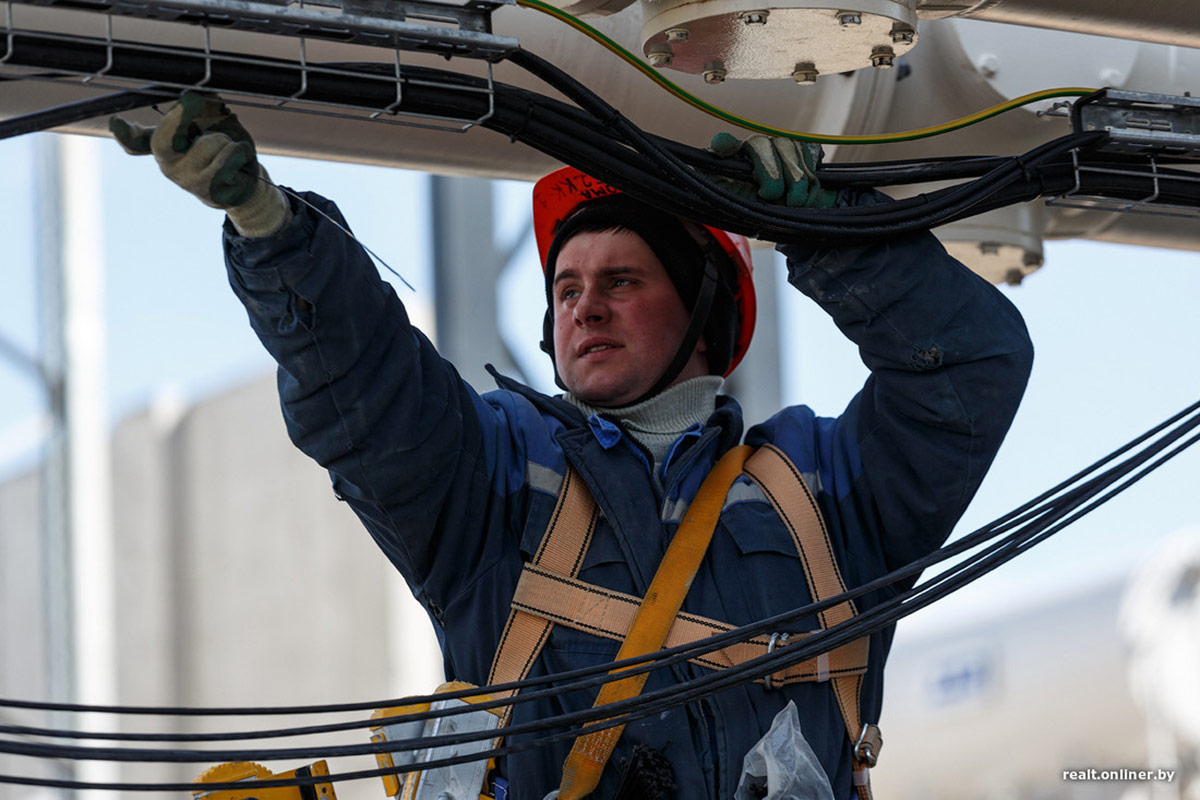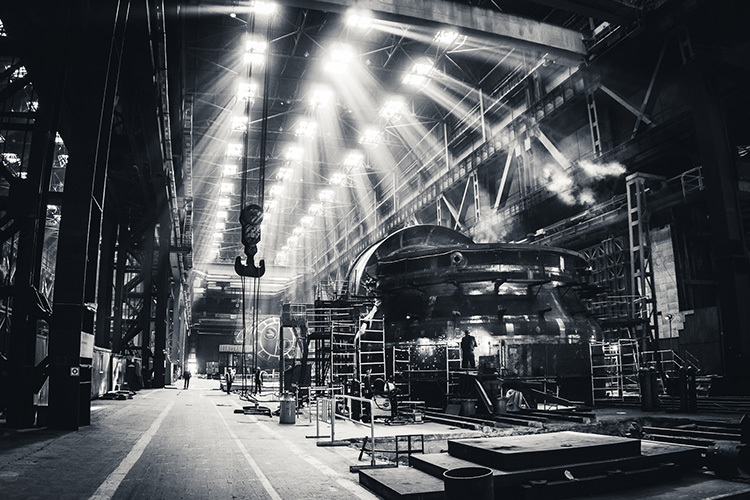An investigation by OCCRP partner Belsat TV, a Poland-based Belarusian satellite TV channel that provides an independent alternative to state-controlled media in Belarus, has uncovered potentially dangerous defects and omissions in the plant’s construction to date.
Andrey Ozharovskiy, a Russian nuclear physicist and environmental activist, says the situation is worrisome.
“Plenty of signals are coming from the Belarusian [plant] construction site that rules are being broken, including by the nuclear watchdogs themselves,” he says. “Reactors are being dropped, knocked against poles. It’s a real mess over there.”
Belarus claims that its national regulatory oversight is sufficiently thorough to allay safety concerns. “All the necessary measures are being undertaken to secure the plant's safety,” the country’s Deputy Energy Minister, Mikhail Mikhadyuk, said on April 20. “All the requirements as far as the construction, inspection, and assembling of the technological equipment are being met in full. The safety of the Belarusian nuclear power plant is our number one priority.”
The plant is being built near the town of Ostrovets in the Grodno region of western Belarus, 22 kilometers (14 miles) from the Lithuanian border and 52 kilometers (33 miles) from the Lithuanian capital of Vilnius. Construction began in 2013, with the first reactor slated for completion in 2019 and a second in 2020.
 The nuclear power plant under construction in Belarus (Photo: onliner.by; Maxim Tarnalitskiy).
The nuclear power plant under construction in Belarus (Photo: onliner.by; Maxim Tarnalitskiy).
The Belsat investigation uncovered the failure of contractors to obtain proper safety certification, accidents caused by these contractors that resulted in possible damage to the critical reactor vessel, and the fact that key parts of the plant’s construction were undertaken by a firm with very little experience in the work.
The plant’s construction has also been proceeding without the usual level of guidance and advice from international experts.
By comparison, the United Arab Emirates (UAE), which is also constructing its first nuclear power plant, asked the International Atomic Energy Agency (IAEA) to conduct 15 pre-launch “peer review missions,” in which a team of IAEA experts measures various parameters to assess whether a country can safely handle nuclear power. To date, seven have been conducted.
Meanwhile, Belarus has asked for only five reviews, none of which has focused on the plant's construction process. To date, it has hosted three.
The UAE missions have focused on regulations, nuclear material security, and the national electricity grid’s readiness to use nuclear power, rather than the construction of the plant. But an IAEA mission in December 2011 rated the independence of Dubai's own nuclear safety regulating body as “high and satisfactory,” meaning it is independent enough from other government agencies to prioritize safety rules over economic considerations.
In a 2012 report, the IAEA said that Belarus, on the other hand, has no acceptably independent regulatory body, meaning that its regulator has neither the technical competence nor the political independence to oversee the plant's safe construction. After another IAEA mission to Belarus in 2016, Minsk did not made the subsequent report public.
Belarus' European Union (EU) neighbors have voiced deep concern. Lithuania and Poland have both announced a ban on importing electricity from the plant, and on June 7, Lithuania declared the plant a threat to its national security. Germany has called on Belarus to seek further assistance from the IAEA. And the plant has repeatedly been a subject of debate in the European Parliament. The Belarusian government has said the energy produced at the plant will be for local consumption.
Lithuania is demanding that a permanent international expert group be dispatched to Belarus to overview the construction process. But Minsk continues to refuse to give any international experts, IAEA included, any input into the construction process, according to Lithuania’s foreign ministry.
Concerns about the plant's location have been reinforced by the fact that the third IAEA mission to Belarus, which took place in January 2017, had its mandate reduced to exclude evaluation of the plant's site.
 A construction worker on the site of the nuclear power plant under construction in Belarus (Photo: onliner.by; Maxim Tarnalitskiy).
A construction worker on the site of the nuclear power plant under construction in Belarus (Photo: onliner.by; Maxim Tarnalitskiy).
The fears of Belarus’ neighbors are fed by still-recent memory of the Chernobyl disaster. Chernobyl has become global shorthand for nuclear catastrophe when, on April 26, 1986, a fire spewed radioactive material from the Soviet-built plant on Ukraine’s border with Belarus across much of the western Soviet Union and Europe.
After the Chernobyl accident, a zone extending 30 kilometers (18 miles) from the site of the accident was declared unsafe for living things. Belarus’ new nuclear plant is less than 22 kilometers (14 miles) from its border with Lithuania, and the plant is closer to the Lithuanian capital of Vilnius than it is to Minsk.
In 2014, a UN committee found Belarus to be in noncompliance with the Espoo Convention, which obliges signatory states to conduct an Environmental Impact Assessment (EIA) in the early planning stages of projects that could be hazardous to the environment and to share the results with other countries that could be affected.
According to the committee, Belarus has failed to ensure proper public participation in the EIA process, to prepare the required documentation, or to carry out proper consultations. For example, one of Lithuania's main concerns was that Belarus had failed to inform it about the geological characteristics of the site.
A subsequent meeting of the parties of the Espoo Convention, which took place in Minsk this June, failed to produce a conclusion on whether Belarus had taken the appropriate steps to improve the situation since 2014. It was decided that further efforts were needed for the parties to reach a consensus. An intermediary session is planned to be held, perhaps in late 2018 or early 2019, to finish the deliberations. The next regular session is scheduled to convene in 2020.
Meanwhile, the Belsat investigation found that Belarus’s own standards are being neglected in the plant’s construction, leading to accidents that may jeopardize its safety during operation.
One standard required under Belarusian law is certification of construction companies. In order to get permission to carry out a construction project, a company must have a qualification certificate, proving that it has the competence, equipment, and financial resources to complete it safely.
The certificates required range from Category 4 for regular homes to Category 1 for skyscrapers and industrial plants that present a danger to the public in case of accident. In the construction of the nuclear plant, however, one of the contractors involved – JSC Stroitel, a Belarusian firm -- has failed to meet the requirements for a Category 1 certificate. Under Belarusian law, this means that it has no right to build any objects at the power plant.
Yet Stroitel has already built several objects at the site, including the automatic fire extinguishing system, a diesel generator designed to power the plant's safety mechanisms in case of nuclear reactor shutdown, and the “gas block,” a safety installation fueled by steam from the nuclear reactor which is designed to cool down the turbine that generates electricity..
This type of cooling system has already failed once at another site, causing a fire at a nuclear power plant in Rostov, Russia, in 2015. That fire was extinguished without damage to the nuclear reactor.
Leonid Frydkin, editor-in-chief of the Belarusian Economic Newspaper, says that the questions surrounding the contractor raise legitimate concerns. “Such omissions should be corrected by the authorities and the guilty punished. If the authorities don’t pay attention to these signals, it throws a shadow on the whole project and gives opponents of [the plant] a legitimate cause for protest,” he says.
Gosstroinadzor, the agency that supervises construction in Belarus, insisted that Stroitel had a construction certificate, but did not respond to reporters’ questions about whether it was of the appropriate level. Gosatomnadzor, the national nuclear watchdog, said that Stroitel does not need a first-level qualification because of its status as a subcontractor. However, reporters found that the company had its own subcontractors on the site, which, according to Belarusian law, means that it cannot be considered a subcontractor itself.

Further problems occurred during the installation of the first reactor vessel, the steel cylinder that encloses the nuclear reactor. During assembly in July, the 330-ton vessel was dropped from a height of several meters. The incident was first reported by independent media, quoting eyewitnesses.
The plant’s general contractor, Rosatom, at first denied the accident had occurred. Later officials admitted there had been an accident, but insisted it had caused no damage. Finally, at the insistence of Belarus' government, Rosatom agreed to replace the vessel, citing the need to assuage public concerns rather than any actual damage.
Those concerns only grew, however, when Rosatom elected to replace the possibly damaged reactor vessel built for the first block with an identical one built for the second block. But the second vessel was banged against a pole as it was being transported to Belarus by rail. The government argued that the mishap did not cause any damage and proceeded with the installation.
Nuclear physicist Andrey Ozharovskiy, however, claims that the impact could have caused micro-damage which is impossible to detect in the field but which might be revealed when the vessel is exposed to a neutron stream during the reactor’s operation.
Concerns about reactor vessel safety are heightened by the fact that it is being produced by a company that, in its current form, has never produced reactor vessels.
In a press release, Atomenergomash, the arm of Rosatom that owns the reactor shell production facility in Volgodonsk, says that the Belarusian vessel is the first one it had constructed in 30 years. Unmentioned, however, is the fact that 20 years ago the factory went bankrupt and its nuclear manufacturing equipment was sold off. It was repurposed to service fossil-fueled power plants, lost the license to manufacture nuclear equipment, and obtained a new one only in 2009.
Some Belarusians economists worried about the plant are concerned that Belarus’ cash-strapped government may be unduly vulnerable to Rosatom’s financial influence.
Belarus has been suffering a prolonged economic downturn, with its gross domestic product (GDP) contracting nearly 40 percent in dollar terms over the past three years. The economic hardships have caused nationwide protests.
The nuclear plant construction is funded by a US$ 10 billion loan from Russia, which represents around one-fifth of Belarus's gross domestic product. The project provides a significant influx into the country’s struggling economy and the finances of the money-losing state-owned enterprises involved in it.
“Belarus needs this loan, so Rosatom is in a position to impose its conditions on [the Belarusian capital of] Minsk,” says Belarusian economist Leu Margolin.






